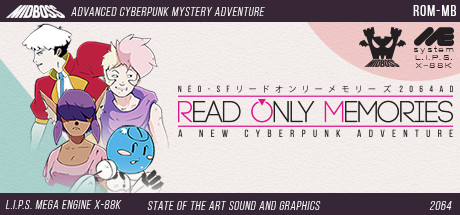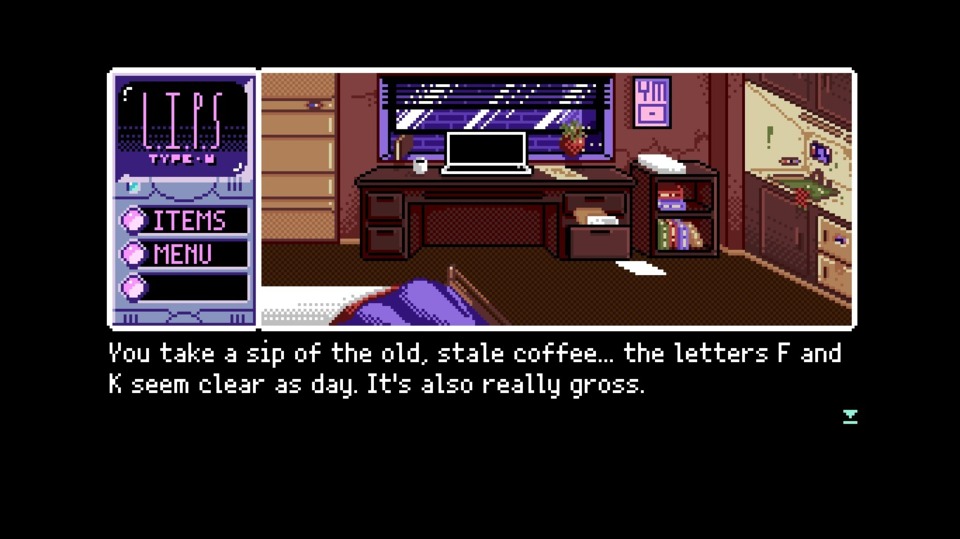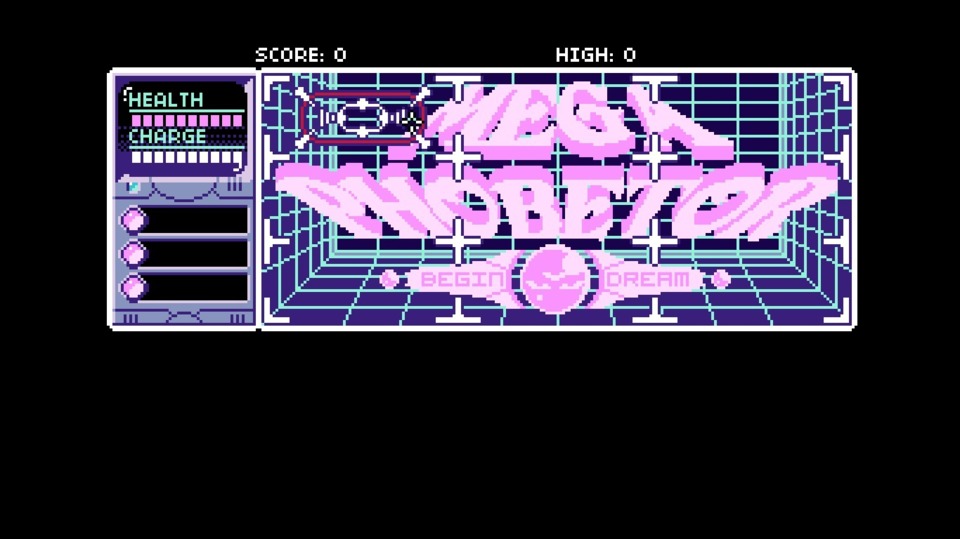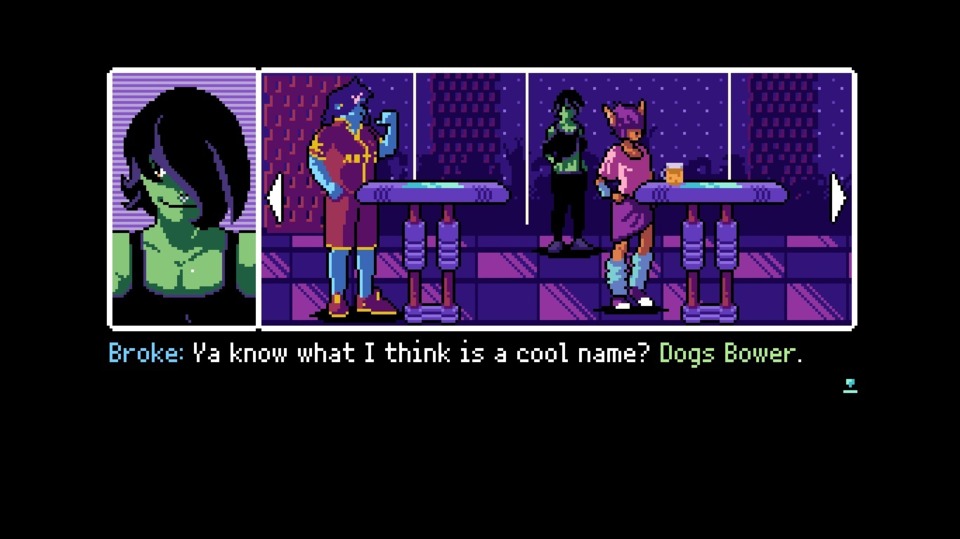Indie Game of the Week 13: Read Only Memories
By Mento 0 Comments

The history of Japanese adventure games runs parallel to the origin and proliferation of Japanese RPGs, and is about as equally curious to those more accustomed to their Western counterparts. Both genres began roughly the same place and time, both were inspired by but not copied directly from Western games, and both - curiously enough - owe a large debt to Yuji Horii, who helped establish both models with Dragon Quest and Portopia Renzoku Satsujin Jiken respectively. There's resources to learn more about this (here's my own take from a while back) but I mention it because Read Only Memories might be one of the more explicit Western-derived homages to this exclusively Japanese model of game that I've ever had the good fortune to play. That's largely because of the cultural bridge that is Konami/Hideo Kojima's Snatcher, which saw a localization for the Mega CD and is the clear inspiration for much of the game's aesthetic, general setting and certain characters and plot details. Snatcher probably seemed like an entirely distinct entity when it first arrived to North America, but beyond its use of voiced dialogue and redbook audio - both of which made possible by the burgeoning CD-ROM format - and its slightly awkward ranged combat, it was based on a model of game that had been present on the early Famicom and MSX systems many years prior. Princess Tomato in the Salad Kingdom for NES is another example of this particular sub-genre that inexplicably saw a localization, though its level of quality and fairytale aesthetic probably didn't endear itself as well as to Western audiences as the Blade Runner-inspired adventures of J.U.N.K.E.R. agent Gillian Seed and his robot sidekick Metal Gear.

Anyway, this really has no bearing on the quality of Read Only Memories. It's just the direction that I happen to be coming at the game, as someone who spends in inordinate amount of their free time researching and writing about Japan-exclusive games for the Giant Bomb wiki. My favorite nostalgic throwbacks so far from the Indie crowd haven't just been the genres that were well-represented in my youth - 2D platformers, point & click graphic adventure games, NES/SNES-era JRPGs - but those that weren't well-represented at all. Unique aberrations, or formats that didn't cross fully into the mainstream, that have been given a new lease of life from a dedicated group of developers that consider them formative to their gaming upbringing, even if that wasn't the case for most. Read Only Memories, before I get into the game proper, scores points with me for recalling a sub-genre so specific and esoteric that it never really saw widespread appeal until many years later in an evolved form with the likes of Ace Attorney, the Zero Escape series, Danganronpa and an influx of visual novels.
Read Only Memories puts the player in the shoes of a hack journalist reviewing budget wireless headphones when a loquacious little robot enters their life. ROMs, the name for these ambulatory personal assistant/organizer robots, are common enough sights, but this one introduces itself as Turing and reveals itself to be a highly advanced sapient variant that its tech genius creator was working on in secret. This creator is revealed to be an old friend of yours, and his recent kidnapping has prompted the little robot to beseech you and your journalistic background to help solve the mystery behind his abduction. So starts a typical cyberpunk detective adventure that has you visit a number of colorful archetypes of the genre for clues, dig deeper behind the disappearance with a smattering of inventory and dialogue puzzles, occasionally put yourself in peril, and read a whole lot of text as characters spend the time to introduce themselves, what they do, and their relevance to the matter at hand. What's remarkable is that the game has the exact cadence of the Japanese adventure game, as they once were. In particular, the game puts a lot of stock into simply being at the right place and time to continue the story, rather than completely shutting down the narrative thread for long stretches so you can explore, talk to NPCs and solve puzzles until you have the right amount of items to progress. Consider something like The Secret of Monkey Island, which gives you an objective for the next stage of the story and then has you spend the rest of that chapter finding the correct objects or convincing the right NPCs in order to continue. Read Only Memories, like the games it was inspired by, is more invested in having the plot constantly happen to you, with only brief pauses to engage in something more active that doesn't involve clicking through pages of dialogue. Considering the Japanese adventure game genre would eventually coalesce into predominantly narrative-focused visual novels, Read Only Memories has clearly done its homework emulating a specific point in its evolution.

There are certain stylistic choices that work for and against the game. The use of a narrow horizontal band of "play field", with dialogue/text using the space beneath, is one I believe that's fairly distinct to the game. Snatcher did compartmentalize its GUI a bit, for the sake of video/animation clips that had to be smaller and more condensed for the sake of what was possible for CD-based games on 16-bit hardware, but with Read Only Memories it feels like the horizontal layout is more of a quirk. The music is generally fantastic, a collection of era-typical MIDI tunes that belie a certain level of complexity and versatility that help establish not only atmosphere but character, through a selection of leitmotifs and other recurring tracks. This attention to detail is made evident a few times, such as how the music blaring out of Club Stardust, a popular bar that the player visits frequently, is a little muffled and obfuscated by traffic noise when you're standing outside the establishment, and gets louder closer to the dance floor. Conversely, I found the voiceover acting, which I am to understand is a fairly recent addition to the game as of 2017, to be fairly mixed. Some of the characters have evident veteran voice actors, while others are voiced by various popular personalities connected to or adjacent to the video game industry. Folk like Indie developer Zoe Quinn, YouTube watchdog and sasspot Jim Sterling, WWE superstar and gaming fan Austin "Xavier Woods" Creed, or noted Taco Bell enthusiast and failed musician @danryckert. While the performances aren't terrible these voices stick out primarily because of the people they're attached to, and also the generally lower quality mics that were used to presumably (and I hesitate to use the term given the connotations) phone those performances in, and while I can appreciate having a fun few celebrity cameos they generally serve to break the immersion, which the rest of the sound design does an otherwise fine job with.
I'd also like to bring up the game's LGBTQ focus, since it's one of the most inclusive games I've played in that regard without necessarily placing it front and center as a major plot component. In addition to various gay, lesbian and bi characters, the player is also taught the importance of pronouns in a world with ever more blurred lines with regards to sexuality and gender identity, allowing the player to customize their avatar with their own preferred choice of pronoun. This doesn't have any bearing on the plot - you never see yourself, no-one seems to refer to your gender, nor are there any sort of romantic subplots concerning your avatar - but it does afford the player to create someone closer to themselves than most games allow if they happen to have a less common gender identity. Likewise, the game makes some political statements about trans folks - a lot of the sentiments made by and about the genetically-modified "hybrid" community seem to run parallel to pro-trans and transphobic talking points, even if I think wanting to turn yourself into an anthropomorphic fox is a tad distinct than someone wanting their biological sex to match their gender identity - and the sapient robot Turing discusses briefly whether they prefer to be a he, she, or they once the subject is broached. Again, this discussion topic is used sparingly throughout the game, and like another recently played cyberpunk game - Technocrat/Wadjet Eye's Technobabylon - is generally a side-effect of a future where gay, trans and queer identities have become more (if not quite universally) accepted and commonplace.

Honestly, I find all these aspects of the game more fascinating than the game itself, which on the whole is more straightforward and linear than most of its contemporaries. That's a deliberate choice for the sake of homage, as previously stated, but it does make it a fairly rudimentary adventure game in comparison to the Indie point and clicks we've seen elsewhere. However, you could make the argument that the heightened focus on narrative is a bigger plus than having more puzzles to solve. I also made the smart choice of putting plenty of space between it and VA-11 Hall-A: Cyberpunk Bartender Action while planning out this feature, because the two games share a lot of similarities - as if to acknowledge this, there's a few crossover characters and references, some of which I imagine got added back into the newer version of Read Only Memories to respond to VA-11 Hall-A's shoutouts. On the whole, though, I think this is a neat throwback with a compelling story and characters, and I'm all about supporting adventure games that aim to resurrect formats more maligned or forgotten - like the resurgence of FMV we've seen of late - or create their own out of whole cloth. In a sense, it's games like Read Only Memories that help to preserve the medium's past, as well as determine its future.
Rating: 4 out of 5.
| < Back to 12: Valley | > Forward to 14: Doki-Doki Universe |
